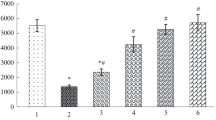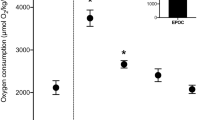Summary
Various metabolic parameters were measured in relation to activity in the salamanderAmphiuma tridactylum. Cutaneous O2 consumption rate (\(\dot V_{O_2 }\)) did not change with activity (Fig. 1B). Pulmonary\(\dot V_{O_2 }\) did not increase during activity, but did increase after activity, repaying the O2 debt (Fig. 1). Changes in lactate, glycogen and glucose indicated that: 1) the energy for activity is primarily derived from oxidation of muscle glycogen to lactate; 2) gluconeogenesis reaches a peak at 5 h after activity; and 3) total replenishment of muscle lactate may not occur until after the animal feeds again (Figs. 2,3). The measured O2 debt of activity was 266.47 μl g−1 (Fig. 1B). The amount of excess lactate generated (1.52 mg g−1), estimates of O2 stores, and estimates of high energy phosphate stores were used to calculate an O2 debt (265.61 μl g−1) which agreed with the measured O2 debt (Fig. 4); 76% is a lactacid and 24% is an alactacid debt. The total energy cost of activity was calculated from similar estimates (Fig. 5). It is suggested thatAmphiuma can remain active longer than other amphibians which have similar anaerobic capacities because of the efficiency of swimming as a means of locomotion. The results are used in interpreting evolution of the lungs ofAmphiuma.
Similar content being viewed by others
References
Baker, C.L.: The natural history and morphology ofAmphiuma. J. Tenn. Acad. Sci.20, 55–91 (1945)
Bennett, A.F., Licht, P.: Anaerobic metabolism during activity in lizards. J. comp. Physiol.81, 277–288 (1972)
Bennett, A.F., Licht, P.: Relative contributions of anaerobic and aerobic energy production during activity in amphibia. J. comp. Physiol.87, 351–360 (1973)
Bennett, A.F., Licht, P.: Anaerobic metabolism during activity in amphibians. Comp. Biochem. Physiol.48A, 319–327 (1974)
Bennett, A.F., Wake, M.H.: Metabolic correlates of activity in the caecilianGeotrypetes seraphini. Copeia (3), 764–769 (1974)
Black, E.C., Robertson, A.C., Parker, R.R.: Some aspects of carbohydrate metabolism in fish. In: Comparative physiology of carbohydrate metabolism in heterothermic animals. Martin, A.W. (ed.), pp. 89–124. Seattle: University of Washington Press 1961
Brett, J.R.: The metabolic demand for oxygen in fish, particularly salmonids, and a comparison with other vertebrates. Resp. Physiol.14, 151–170 (1972)
Cagle, F.R.: Observations on a population of the salamander,Amphiuma tridactylum. Ecology29, 479–491 (1948)
Carlson, F.D., Hardy, D., Wilkie, D.R.: The relation between heat produced and phosphorylcreatine split during isometric contraction of frog's muscle. J. Physiol.189, 209–235 (1967)
Cerretelli, P., di Prampero, P.E., Ambrosoli, G.: High-energy phosphate resynthesis from anaerobic glycolysis in frog gastrocnemius muscle. Am. J. Physiol.222, 1021–1026 (1972)
Cohen, J.J., Little, J.R.: Lactate metabolism in the isolated perfused rat kidney: relations to renal function and gluconeogenesis. J. Physiol.255, 399–414 (1976)
Conant, R.: A field guide to reptiles and amphibians of eastern and central North America. Boston: Houghton Mifflin 1975
Czopek, J.: Vascularization of respiratory surfaces in some Caudata. Copeia (4), 576–587 (1962a)
Czopek, J.: Smooth muscles in the lungs of some Urodeles. Nature193, 798 (1962b)
Darnell, R.M.: Environmental factors which determine the habitat ofAmphiuma. J. Tenn. Acad. Sci.23, 3–12 (1948)
Feder, M.E.: Lunglessness body size, and metabolic rate in salamanders. Physiol. Zool.49, 398–406 (1976)
Gratz, R.K., Hutchison, V.H.: Energetics for activity in the diamondback water snake,Natrix rhombifera. Physiol. Zool.50, 99–114 (1977)
Guimond, R.W., Hutchison, V.H.: Pulmonary branchial and cutaneous gas exchange in the mud puppy,Necturus maculosus maculosus. Comp. Biochem. Physiol.42A, 367–392 (1972)
Guimond, R.W., Hutchison, V.H.: Trimodal gas exchange in the large aquatic salamanderSiren lacertina. Comp. Biochem. Physiol.46A, 249–268 (1973)
Guimond, R.W., Hutchison V.H.: Aerial and aquatic respiration in the congo eelAmphiuma means means. Resp. Physiol.20, 147–159 (1974)
Hilman, S.S.: Cardiovascular correlates of maximal oxygen consumption in anuran amphibians. J. comp. Physiol.109, 199–204 (1976)
Hutchison, V.H., Turney, L.D.: Glucose and lactate concentrations during activity in the leopard frog,Rana pipiens. J. comp. Physiol.99, 287–295 (1975)
Hutchison, V.H., Turney, L.D., Gratz, R.K.: Aerobic and anaerobic metabolism during activity in the salamanderAmbystoma tigrinum. Physiol. Zool.50, 189–202 (1977)
Johansen, K.: Cardiovascular dynamics in the amphibianAmphiuma tridactylum. Acta Med. Scand. Suppl.402, 1–82 (1963)
Johansen, K., Lenfant, C., Hanson, D.: Cardiovascular dynamics in lungfishes. Z. vergl. Physiol.59, 157–186 (1968)
Johansen, K., Hansen, D., Lenfant, C.: Respiration in a primitive air breather,Amia calva. Resp. Physiol.9, 162–174 (1970)
Jones, D.R.: Anaerobiosis and the oxygen debt in an anuran amphibian,Rana esculenta. J. comp. Physiol.77, 356–382 (1972)
Knuttgen, H.G.: Lactate and oxygen debt: an introduction. In: Muscle metabolism during exercise. Pernow, B., Saltin, B. (eds.), pp. 361–367. New York: Plenum Press, 1971
Lenfant, C., Johansen, K.: Respiratory adaptations in selected amphibians. Resp. Physiol.2, 247–260 (1967)
Lomholt, J.P., Johansen, K.: Gas exchange in the amphibious fish,Amphipnous cuchia. J. comp. Physiol.107, 141–157 (1976)
McGilvery, R.W.: Biochemistry, a functional approach. Philadelphia: Saunders 1970
Naimark, A., Wasserman, K., McIlroy, M.B.: Continuous measurement of ventilatory exchange ratio during exercise. J. Appl. Physiol.19, 644–652 (1964)
Packard, G.C.: The evolution of air-breathing in paleozoic gnathostome fishes. Evolution28, 320–325 (1974)
Penn, G.H.: Utilization of crawfishes by cold-blooded vertebrates in the eastern U.S.. Am. Midl. Nat.44, 643–658 (1950)
Piiper, J., di Prampero, P.E., Cerretelli, P.: Oxygen debt and high-energy phosphates in gastrocnemius muscle of the dog. Am. J. Physiol.215, 523–531 (1968)
Rahn, H., Rahn, K.B., Howell, B.J., Gans, C., Tenney, S.M.: Air breathing of the garfish (Lepisosteus osseus). Resp. Physiol.11, 285–307 (1971)
Romer, A.S.: The vertebrate body. Philadelphia: Saunders 1970
Schmidt-Nielsen, K.: Locomotion: energy cost of swimming, flying, and running. Science177, 222–228 (1972)
Seymour, R.S.: Physiological correlates of forced activity and burrowing in the spadefoot toad,Scaphiopus hammondil. Copeia (1), 103–115 (1973)
Shelton, G.: The effect of lung ventilation on blood flow to the lungs and body of the amphibianXenopus laevis. Resp. Physiol.9, 183–196 (1970)
Sokal, R.R., Rohlf, F.J.: Biometry. San Francisco: Freeman 1969
Szarski, H.: The structure of respiratory organs in relation to body size in amphibia. Evolution18, 118–126 (1964)
Toews, D.P.: Factors affecting the onset and termination of respiration in the salamander,Amphiuma tridactylum. Can. J. Zool.49, 1231–1237 (1971)
Toews, D.P., Shelton, G., Randall, D.J.: Gas tensions in the lungs and major blood vessels of the urodele amphibian,Amphiuma tridactylum. J. Exp. Biol.55, 47–61 (1971)
Tucker, V.A.: Energetic cost of locomotion in animals. Comp. Biochem. Physiol.34, 841–846 (1970)
Turney, L.D., Hutchison, V.H.: Metabolic scope, oxygen debt and the diurnal oxygen consumption cycle of the leopard frog,Rana pipiens. Comp. Biochem. Physiol.49A, 583–601 (1974)
Ultsch, G.R.: Gas exchange and metabolism in the Sirenidae (Amphibia: Caudata) I. Oxygen consumption of submerged sirenids as a function of body size and respiratory surface area. Comp. Biochem. Physiol.47A, 485–489 (1974)
Wasserman, K., Whipp, B.J., Koyal, S.N., Beaver, W.L.: Anaerobic threshol and respiratory gas exchange during exercise. J. Appl. Physiol.35, 236–243 (1973)
Williamson, J.R., Jakob, A., Scholz, R.: Energy cost of gluconeogenesis in rat liver. Metabolism20, 13–26 (1971)
Author information
Authors and Affiliations
Rights and permissions
About this article
Cite this article
Preslar, A.J., Hutchison, V.H. Energetics for activity in the salamanderAmphiuma tridactylum . J Comp Physiol B 128, 139–146 (1978). https://doi.org/10.1007/BF00689477
Accepted:
Issue Date:
DOI: https://doi.org/10.1007/BF00689477




